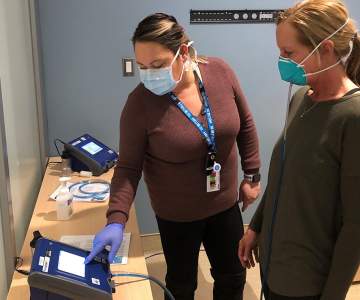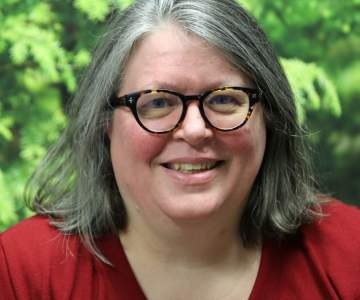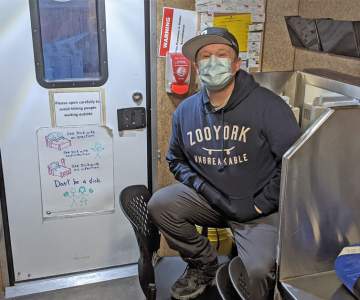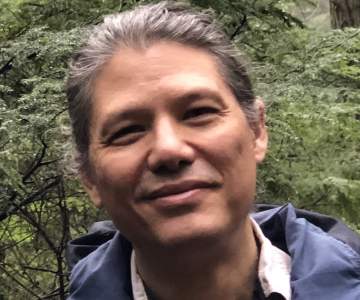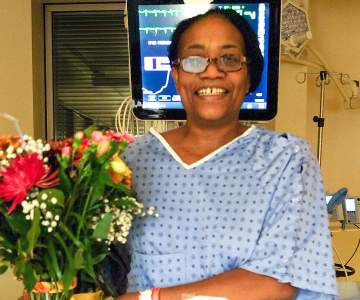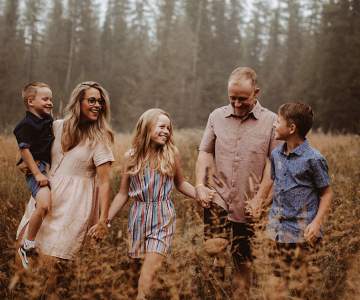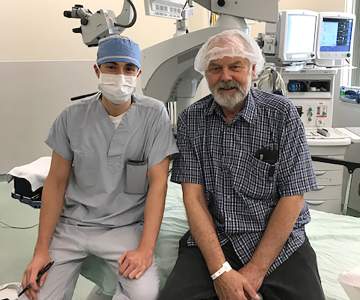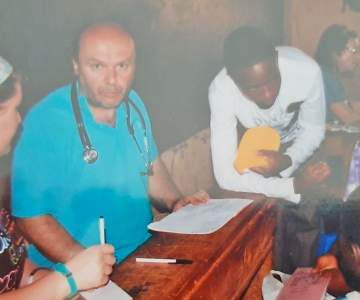Breadcrumb
Explore Stories
Health & Wellness
In This Together is a series dedicated to the stories of people contributing to our COVID-19 response.
Amanda Neigum knows full well we are in this together.
As a patient porter, Amanda and her colleagues at Kelowna General Hospital are responsible for helping with the transportation of patients, equipment, specimens and supplies throughout the facility.
But that was pre-pandemic for Amanda, who has also worked in medical imaging, equipment and central supply for personal protective equipment since joining Interior Health about two years ago.
When COVID-19 hit, Amanda was offered the opportunity to become a fit-tester, helping health-care professionals be properly fitted for N95 masks and other respirators.
And she jumped right in, performing some 2,000 fit-tests in the first 12 months of the pandemic.
“I have just really focused on getting as many people through the door that need to be fit-tested as possible,” says Amanda. “It is extremely important for those staff members that are using the respirators daily to be up-to-date on their fittings.”
Quantitative fit testing is the most accurate form of a fitting. It’s a data driven approach to determine the fit of a respirator on an individual’s face. Specialized equipment measures the amount of leakage around the seal. Amanda and her colleagues also explain how to put on, remove, and properly wear a respirator. This is critical to keeping health-care workers safe.
“At times it has been challenging and stressful but together we manage to pull through and do the best we can,” she says. “The support from the community has been very humbling and has helped to push us through the difficult times.”
“A lot has changed since COVID hit. We have had to follow new rules and guidelines. We have taken on new roles and have faced experiences we have never had to face before,” says Amanda.
As we have all experienced, things change fast when you are dealing with a pandemic. You have to be nimble and be able to adjust on the fly. It’s something that Amanda is prepared to keep on doing in an effort to keep people safe.
And sometimes, luck has a way of finding those who most deserve it. Last week, Amanda was the winner of the Kelowna General Hospital Foundation's 50-50 lottery, which helps support its many important fundraising efforts.
Community & Culture
It's all about our people. The people who we serve and the people that work for us and with us. We are nothing without our people. Together, we are stronger. Their innovation, dedication, compassion, and commitment to serving our communities are what makes us a Top 100 BC Employer.
To be acknowledged as a 2021 BC Top Employer is an absolute honour. It's really a reflection of our incredible staff who works together as a team to provide the best service possible to our communities across the southern Interior of British Columbia.
It's humbling to accept this award, especially amidst the challenging past year working through a pandemic. We were all hit hard, especially in health care. It was with the dedication from our 21,000+ employees that we're able to continue to deliver safe and essential health care services that our communities require daily.
Thank you to our team of health care heroes for their service and dedication throughout the pandemic; we are stronger together.
In the article, Interior Health goes for a workplace 'perfect mix', they outlined a few reasons why Interior Health was selected as a BC Top Employer for 2021:
Interior Health Authority maintains a variety of policies to enable employees to take time for themselves, offering a minimum of four weeks of starting vacation allowance for most employees, up to 18 paid sick days annually, and flexible work options where possible
Interior Health Authority helps employees prepare for life after work with retirement planning assistance and generous contributions to a defined benefit pension plan
Interior Health Authority recognizes exceptional employee performance through internal awards in a variety of categories including long service, BC Health Care Hero Awards, and quality improvement awards for those who contribute to improving the quality of care provided to patients and families
“I am so proud of each and every person who works at Interior Health. Together, we share a commitment to our communities that is reflected in the dedication, compassion, and innovation our teams bring to the health system.”
Susan Brown, President & CEO
Stay updated with careers at Interior Health
@IHJobs | @InteriorHealthBC.Careers | @InteriorHealthAuthority
Explore a Career at Interior Health
Research & Innovation
Michelle Hewitt has had a lot of experience receiving health care. She is also a passionate advocate for people with disabilities, a former school principal and an academic. Her unique perspective and history are a few of the reasons she has been asked to contribute her thoughts on Interior Health programs and services.
Michelle is a patient partner and a member of the Patient Voices Network, a community of patients, families and caregivers in B.C. who work with organizations like Interior Health to improve our health-care system.
Patient participation is an important component of how new services and programs are developed. Interior Health benefits greatly from having the perspective of those receiving health-care services.
But patient partners bring far more than their experience as a patient to the table. They offer a unique view based on their professional training, past work experience and unique encounters with our health-care system.
What led you to becoming a patient partner?
"I became involved because it's important me to be an advocate for disabled people," says Michelle. "I have participated in other types of volunteer opportunities, but I wanted to have an impact closer to home. I responded to be a volunteer for a local project that had patient involvement in research and then continued to work with other Interior Health projects."
"To be honest, I struggle with the word patient. Everyone in our region is could consider themselves a patient as we all receive some type of health care. We're just people. As people, the experience we go through is very individual. It's also collective because as groups of people we go through the same experiences."
Beyond your unique perspective, what else do you bring to this partnership?
"Prior to being diagnosed with Multiple Sclerosis, I was a school principal with school district 23. Even though I no longer work in that capacity, I certainly bring that administrative lens to the work I'm engaged with. I am also working on my PhD at the moment. My research is focusing on care for young adults who live in long-term care homes. So I have a personal and an academic understanding of how these large systems work and what is required to affect change."
How do patient partners improve care?
"I think it's essential to have the people receiving programs and services involved in their development. As patient partners, we bring the focus back to the experience of the person receiving care. That's an important lens to have in these discussions."
"Don't get me wrong, having patient involvement is hard. It's messy and complicated and requires some difficult conversations. But it's also absolutely necessary."
These stories are built on the work originally started by Tatianna Henderson, Student Intern, Quality & Patient Safety.
Community & Culture
We are IH is a recognition campaign to spotlight Interior Health employees and medical staff – through pictures and stories.
Name: Rikki Barden
Worksite: Supervised Consumption Site, Kamloops
Years of Service: 3.5
Job Title: Social Worker
"You don't know what you don't know, is a quote I find myself saying a lot. I have no problem acknowledging that even though I can be looked at as the all-knowing professional who should have all the answers and cures for people's problems, I do not. And that's ok. It creates an opportunity to learn something new either by myself or with my clients. I think that being honest about the extent of my knowledge can create opportunities for clients to take on the teaching role and be the experts in something, which is invaluable when building and maintaining relationships. ” -Rikki Barden, Social Worker, Kamloops
Rikki's optimistic outlook, easy-going personality, and welcoming nature puts smiles on the faces of those around him. His infectious energy seeps through the worksite creating a positive environment and a safe place for people to come together.
As a Social Worker for Interior Health at a Safe Consumption Site in Kamloops, Rikki feels grateful to have what he describes as the best job he could ask for. Supported by his incredible coworkers and community, he builds relationships every day that are meaningful and inspirational.
Social Workers are an integral part of our health-care system providing essential services. To help us celebrate the essential service of Social Workers, Rikki has graciously shared his journey as a Social Worker at Interior Health.
Breaking down barriers and stigma for stereotypical views of drug users, he works to support and educate others. Rikki is the first to lend a helping hand and support someone in need. Feeling a sense of pride and satisfaction guiding people through systems that can be overwhelming, he feels privileged to earn their trust and hear their stories. Seeing the ripple effect of each positive change in someone's life is very rewarding, especially to know that future generations will be positively impacted.
One of his proudest moments at Interior Health is one that brings a smile to his face reading the precious words written by a client's mother. "He was very encouraged and deeply grateful to find his illness so accurately represented. The last write-up on the report brought us both to tears. Thank you for being the caring human being that you are, people like you are so rare. So rare that if you were a butterfly we would have you nicely framed."
Born and raised in Leigh-On-Sea, Essex, England, his family relocated continents to Kamloops, where he has lived most of his life and where he is currently raising his own family. Outside of work, you can find Rikki with his pride and joy, his partner Krissy, and his little girl, Ripley. They love to spend most of their time together playing outside kayaking in the summer, or inside playing video games and enjoying a movie, preferably one with Hugh Grant in it. He is looking forward to a time where you can be closer than six feet with family and friends, playing softball, frisbee golf, and just simply enjoying the beautiful outdoors together.
In his line of social work, he is hopeful for a future where a safe supply is readily available and accessible. Thank you, Rikki, for all that you do! We appreciate you.
Nominate your colleagues to keep the We Are IH loop going: Name: Gaudenza Ramunno, Nurse, Kamloops Message: Guadenza is amazing. She went back to school in her 40s, after raising four kids. She became a nurse and spent many years with public health as a street nurse. She has pioneered many start-up programs and has been the main fixture on the Kamloops Safe Consumption Site for almost five years. She was awarded Kamloops's mentor of the year and is many people's first call when looking to access flexible, primary nursing care.
For more information contact EmployeeExperience@InteriorHealth.ca.
Stay updated with careers at Interior Health
@IHJobs | @InteriorHealthBC.Careers | @InteriorHealthAuthority
Community & Culture
Dr. Sean Wachtel admits he was surprised – and unpleasantly so – at what he found when he arrived in Canada to begin practicing medicine a decade ago.
After coming from the United Kingdom, he began working in the emergency room at Nelson’s Kootenay Lake Hospital. The last thing he expected was to be confronted by an environment that included discriminatory attitudes about the people he was treating.
"When I first came to Canada, I was completely unaware of the racism and discrimination that exists here," he says. "It was an unpleasant surprise to find this is the situation in the country and province I've chosen to move to."
Ten years later, Dr. Wachtel finds himself in a position where he can make a real difference in combatting racism in the health-care system.
As Interior Health's senior medical director for Aboriginal health, a key part of his role is exploring how a health-care system that embraces and models cultural safety and humility links to improved health outcomes for Aboriginal peoples.
The seeds for this opportunity were planted several years ago when Dr. Wachtel was working as a public health specialist with First Nations Health Authority. That’s when he first met Dr. Mike Ertel, vice president of quality and medicine at Interior Health. Dr. Ertel asked him to join the team as part of the organization's journey to address anti-Aboriginal racism. In this role, Dr. Wachtel works across portfolios at the regional and provincial level.
Dr. Wachtel is on his own journey and says, "I hope that my Aboriginal patients feel their culture and heritage matter when we discuss treatment -- and they receive the same high standard of care I try to offer all of my patients."
I hope my Aboriginal patients feel their culture and heritage matter when we discuss treatment -- and they receive the same high standard of care I try to offer all of my patients. ~ Dr. Sean Wachtel
Learn more about Dr. Wachtel on Season 3 Episode 1 of the Interior Voices podcast.
Launched in 2019, Interior Voices is an informal, ongoing conversation around cultural safety and Aboriginal health. Now entering its third season, the series has become an important educational resource for our care teams. The podcast also offers a glimpse into the people and programs within Interior Health which support this important area of care.
Interested in learning more? Check out these highlights:
Interior Voices Season 3 Episode 1: Dr. Sean WachtelVanessa and Dr. Wachtel discuss the importance of Territory Acknowledgements The X-Change Session 3 – Aboriginal Health: A Physicians Journey to Cultural HumilityThe Four Agreements of Courageous ConversationsRacist Like Me — A Call to Self-Reflection and Action for White Physicians
Health & Wellness
When Penticton resident Betty Lou Thomas woke up in her local hospital’s intensive care unit, she had no memory of what had happened. The last thing she remembered was sitting in a waiting room at her gym on a fall November day. She had suffered a cardiac arrest and collapsed without warning. Twenty-four hours later, she was transferred to the cardiac care unit at Kelowna General Hospital (KGH).
Luckily for Betty, just a few days earlier the new Marshall Eliuk Cardiac Interventional and Advanced Heart Rhythm Program had opened at KGH, meaning she did not have to travel any farther for care. The advanced heart rhythm program is a partnership between Interior Health, Cardiac Services BC and the KGH Foundation, which raised $7 million for the program.
After a series of tests, Betty had an implantable cardioverter-defibrillator (ICD) surgically inserted in her chest in the newly completed lab, which opened as part of the advanced heart rhythm program. The ICD is designed to shock her heart back into normal rhythm if necessary. The day after the procedure, she was back home in Penticton, resting and recovering.
“Honestly, it was a phenomenal experience,” said Betty. “Even though it was a scary procedure and scary what happened, I felt very comfortable. Everyone was so knowledgeable. We are lucky to have this in Kelowna. Now, for everyone who needs this in the Interior, it’s so close, rather than us going to Victoria.”
Opening the Electrophysiology Lab at KGH allowed Interior Health to add the advanced heart rhythm program to other specialty cardiac services at the hospital, including medical cardiology and cardiac surgery inpatient units, a coronary care unit, a cardiac surgery intensive care unit, cardiac imaging and an intervention lab. Patients from across the Interior region who need higher-level cardiac care can now access the full range of services in Kelowna.
As well, services are available at Royal Inland Hospital in Kamloops, where there is a coronary care unit, medical cardiology inpatient unit, and cardiac outpatient clinics. In addition, internal medicine specialists provide cardiac care in Cranbrook, Vernon, Salmon Arm, Penticton and Trail.
Community support for the program was critical and the KGH Foundation’s call to raise money for advanced heart rhythm services struck a chord with donors. In less than a year, the foundation raised $7 million for the needed equipment in the Electrophysiology (EP) Lab.
The establishment of the EP Lab at KGH not only enhances care for patients in IH, it contributes to an expanding network for cardiac services within the province. Patients across B.C. will benefit because of an overall increase in capacity for the management of heart rhythm disorders.
For cardiac patients like Betty Lou Thomas, having services closer to her Penticton home made a hard situation that much easier. Betty is grateful her experience took place just about an hour from her hometown instead of having to travel much farther.
“It’s wonderful for our community that we have this service because heart problems are something so many people have. This can happen to anybody and we are lucky to have such an efficient and effective service so close to home,” she said.
Community & Culture
We are IH is a recognition campaign to spotlight Interior Health employees and medical staff – through pictures and stories.
Name: Kara Hannigan
Job Title: Human Resources Business Partner
Years of Service: 12.5
Worksite: Kiro Wellness Centre
Favourite Quote: “For what it’s worth: it’s never too late, or in my case, too early to be whoever you want to be. There’s no time limit, stop whenever you want. You can change or stay the same, there are no rules to this thing. We can make the best or the worst of it. I hope you make the best of it. And I hope you see things that startle you. I hope you feel things you never felt before. I hope you meet people with a different point of view. I hope you live a life you’re proud of. If you find that you’re not, I hope you have the courage to start all over again.” - F. Scott Fitzgerald
With an honest heart, a creative mind, and quick wit, Kara brings instrumental value to her role at Interior Health, as a Human Resources Business Partner. Over her 12+ years of service, she has created positive change, brought creative ideas to life, and impacted the health and wellness of many. Passionate about bringing people together and promoting a healthy and safe work environment for the collective, she has been part of the driving force behind Pink Shirt Day at Interior Health, especially at her worksite at Kiro Wellness Centre in Trail.
"Pink Shirt Day embodies our commitment to a workplace that is free of discrimination and harassment as outlined in our AU1000 policy. It is everyone’s responsibility both personally and professionally to stand up against harmful behaviour & to recognize the many forms of bullying, address concerns and strategize solutions with kindness." -Kara Hannigan, Human Resource Business Partner, Trail
Eager to be part of the change, Kara understands the importance of being actively involved in the work. Her sense of pride comes from being part of the Employee and Labour Relations team that works to educate managers and staff on Interior Health's internal process to proactively equip them with the tools and resources to positively influence the workplace.
Kara's cupcakes from Pink Shirt Day in 2013
This year for Pink Shirt Day, the theme is to "lift each other up" and support programs that encourage healthy self-esteem and teach empathy, compassion, and kindness. Bringing people together is even more important than ever before in light of the pandemic. Although this year Kara's colleagues, friends, and family won't be able to enjoy her delicious cupcakes, they will continue to show their support.Kara's enthusiasm and efforts year and after year to rally the site and the broader team will continue to generate greater participation and impactful change.
Born and raised on the ancestral Ktunaxa territory (Trail, BC), Kara was excited to raise her family with her husband, Karl, in the same tight-knit and loving community she was raised in. She was eager to pursue her education and graduated from the Univesity of Lethbridge with a degree in Human Resource Management and Labour Relations. Her education, experience, and enthusiasm has propelled her career forward at Interior Health.
While raising her three incredible children, Keltie, Kalen, and Kase, she has achieved amazing feats in both her personal and professional life. Undoubtedly, she has put her heart into her work and it shows. In 2015, BC Health Care Awards recognized her efforts in supporting the placement of differently-abled employees, as part of a Duty-to-Accommodate pilot project.
When Kara isn't working in the office or at home, she is spending time exploring the beautiful outdoors. As an avid cross-fitter and wanna-be runner. During the summer months, you can find her camping with family, exploring scenery with her dog, Leo, and her three children. Living the four-season lifestyle that the Kootenay winters offers, she spends time skiing, both cross-country and downhill, taking in the picturesque views from the mountain top. Passionate about exploring and watching her kids grow and learn, she is most happy exploring alongside them seeing life through their eyes. Thank you for all that you do, Kara! We appreciate you very much.
Nominate your colleagues to keep the We Are IH loop going: Name: Tamara Roscoe Message: Tamara is an amazing nurse who will go the extra mile to ensure your experience is a positive one! She is thorough and thoughtful, compassionate and kind. Our very own superhero, here in Trail! Too often we underestimate the power of a smile, kind words, or a listening ear but it comes so naturally to Tamara; she's pure magic!
For more information contact EmployeeExperience@InteriorHealth.ca.
Stay updated with careers at Interior Health
Facebook: Interior Health | Instagram: interiorhealthbc
| LinkedIn: Interior Health Authority
Health & Wellness
As Herb Armishaw sat in a waiting room at the hospital in Williams Lake one day last fall, he began chatting with others who had joined him there.
Herb is from Forest Grove, a community of about 300 people near 100 Mile House. He learned that others came from places such as Clinton and Hathaway, other nearby communities in the Cariboo region. No matter where they came from, they all had one thing in common: they were waiting for cataract surgery on the first day it was offered at Cariboo Memorial Hospital (CMH).
“I thought it was wonderful having the surgery in Williams Lake,” says Herb. “It saved us a lot of travelling and the weather wasn’t the greatest. The surgical team was excellent. I was really impressed. It went really well.”
People across the Cariboo region now have access to more Interior Health services in Williams Lake, thanks to a recent expansion of surgical procedures offered at CMH. It will allow patients like Herb to access surgeries closer to home, and support physician recruitment and retention in the area.
The expansion includes day surgeries for pediatric dentistry, ophthalmology, orthopedics, ear, nose and throat (ENT), and urology, all made possible through a collaboration with surgeons in the Thompson Cariboo Chilcotin region who will travel to Williams Lake on a regular basis to meet with patients at CMH.
One of those surgeons is Dr. Michael Ross, an ophthalmologist who operates a clinic in Kamloops. For three days a month, Dr. Ross will now also perform cataract surgeries in Williams Lake.
“Patients used to have to come to Kamloops for surgery and a lot of them would stay overnight and see me the next day for follow-up, so this way they don’t have to,” says Dr. Ross. “It’s hard for a lot of patients to travel so it saves them the trip which is very helpful.”
The services began launching in phases, beginning with an expansion of pediatric dental surgery late last summer followed by ophthalmology, ENT, orthopedics and urological surgical services.
On the first three days he was there, Dr. Ross and his team performed 14 procedures at CMH. Five days after his surgery, Herb’s eyesight was improving and he had just received a follow up call from Dr. Ross, checking on his patient.
“I’m on day five and it’s much improved. My vision is a lot brighter,” he says. “Everything seems really good. To me, and to everybody that was in the waiting room with me, we were all very happy that we could have our surgeries done in Williams Lake.”
The Ministry of Health provided $2.4-million for the surgical equipment while the CMH Foundation and the Hough Memorial Cancer Fund Society supported the purchase of $250,000 in equipment.
For referrals to any of the new services, see your primary care practitioner.
New surgical services being offered at CMH:
•Pediatric dental surgery provided by local dentists Dr. Nadeem Ahmad and Dr. Simmy Dhillon;
•Cataract surgery provided by Dr. Michael Ross, who operates a clinic in Kamloops and provides community clinics in Williams Lake during his monthly visits; and
•Ear, nose and throat surgical services provided by Dr. John Cleland from Kamloops, who will also provide community clinics in Williams Lake.
•Orthopedic surgery, provided by Dr. Tyler MacGregor, an orthopedic surgeon who practices out of Kamloops and already provides community clinics at CMH, and
•Urology surgery, provided by Dr. Ellen Forbes, who will provide surgical services and community clinics.
The CMH cataract surgery team during the first days of the new surgical expansion.
Community & Culture
We are IH is a recognition campaign to spotlight Interior Health employees and medical staff – through pictures and stories.
Name: Dr. Josef Owega
Worksite: 100 Mile House Hospital
Years of Service: 14
Job Title: Physician, Chief of Staff
Quote: "Don't jump to conclusions. We are in this together. Be kind."
A true believer in helping others and spreading kindness, Dr. Owega continues to bring these practices into his work at Interior Health as Chief of Staff at 100 Mile House Hospital.
As a rural doctor, he thrives in the unpredictability of the emergency department with the opportunity to make a big difference in someone's life when they are at their most vulnerable. With a wealth of knowledge and experience spanning decades, he has continued to lead his team as the Chief of Staff through the ongoing pandemic to support their surrounding communities.
Choosing to focus on the silver linings of difficult situations, Dr. Owega is proud of how his community has supported each other in the face of the pandemic. These changes have allowed people to grow and find innovative approaches, including working from home, creating new businesses, and expanding the reach of telehealth. His presence inspires those around him as he encourages everyone to do their best, think about others and protect those that we know and love.
CMAT team in Haiti after the earthquake in 2010
Dr. Owega's experience navigating uncertain times was extremely valuable as he stepped up to the position of Chief of Staff to lead his community through the wildfires in 2017. Bringing his community together to support one another was crucial in these life-changing moments.
As a physician and member of his community, he continues to play a crucial role in helping improve the lives of those around him. Born in Austria, his family moved to Canada when Dr. Owega was just two years old. Spending his childhood on the West Coast of Canada in the lower mainland, he was eager to choose a career path where he could help others, whether big or small. Inspired by his parents who are both physicians, he moved out east to Ontario for medical school at Queens University. After graduation, he relocated to Alberta for his residency and gained hands-on experience that would inspire him to further pursue rural medicine.
His career path led him home to British Columbia where he has spent the past two decades practicing rural medicine for nine years in Elk Valley, five years in McBride, and most recently the past seven years in the Cariboo. Spanning his successful career he has brought his passion for helping others to positively impact the lives of so many.
Dr. Owega is known and loved for his down-to-earth personality, kind demeanour, and helping hand in his small community. His open mind and ability to see multiple perspectives adds great value to his integral role in practicing medicine and teaching others.
After a long shift in the ER, Dr. Owega switches from his scrubs to his beekeeping suit to help his beloved wife who tends full time to their bee farm. Spending most of his time outside on his own farm, hiking scenic trails, or hitting the slopes, he continues to find ways to connect with nature, his family, and his community.
Over the past 30 years, Dr. Owega and his incredible wife have grown their family to include four biological children, one foster son, and their awesome adopted niece who joined their family a few short months after they said I do. His family brings him an incredible amount of pride and joy as they embark on new journeys including the online world of university.
Practicing what he preaches, he does his part in helping his neighbours in more ways than medicine. His vast knowledge and thoughtful approaches to situations allows others to feel supported in their tight-knit community. Dr. Owega shares his message to spread love and kindness throughout his community and asks that we all do the same. We are incredibly lucky to have Dr. Owega at Interior Health continuing to help others through his work. Thank you for all that you do!
Bringing Hawaii to his home to celebrate his birthday with family
Nominate your colleagues to keep the We Are IH loop going: Name: Teressa Allwood Message: The manager at 100 Mile House and a nurse extraordinaire. She thinks, gets things done, and took on evacuating the hospital during the fires three years ago. She just amazes me.
For more information contact EmployeeExperience@InteriorHealth.ca.
Stay updated with careers at Interior Health
Facebook: Interior Health | Instagram: interiorhealthbc
| LinkedIn: Interior Health Authority
-
Load More
Showing 657 of 796
Sign up for email updates
Receive news, alerts, public service announcements and articles right to your inbox.


